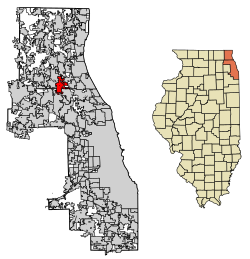Buffalo Grove, Illinois | |
|---|---|
 Sign welcoming drivers into Buffalo Grove | |
 Interactive map outlining Buffalo Grove | |
 Location of Buffalo Grove within Lake and Cook County | |
| Coordinates: 42°9′59″N 87°57′48″W / 42.16639°N 87.96333°W[1] | |
| Country | United States |
| State | Illinois |
| County | Lake and Cook |
| Townships | Vernon and Wheeling |
| Incorporated | 1958 |
| Government | |
| • Type | Council–manager |
| • Village President | Eric Smith |
| • Village Board | Trustees[2]
|
| Area | |
| • Total | 9.58 sq mi (24.81 km2) |
| • Land | 9.56 sq mi (24.77 km2) |
| • Water | 0.02 sq mi (0.04 km2) |
| Elevation | 682 ft (208 m) |
| Population (2020) | |
| • Total | 43,212 |
| • Density | 4,518.67/sq mi (1,744.63/km2) |
| Time zone | UTC-6 (CST) |
| • Summer (DST) | UTC-5 (CDT) |
| ZIP code(s) | 60089 |
| Area code(s) | 847 and 224 |
| FIPS code | 17-09447 |
| GNIS ID | 2397490 |
| Commuter rail | |
| Website | www |
Buffalo Grove is a village in Lake and Cook Counties in the U.S. state of Illinois. A suburb of Chicago, it lies about 30 miles (50 km) northwest of Downtown Chicago and 20 miles (32 km) north of O'Hare International Airport.[a] As of the 2020 Census, Buffalo Grove has a population of 43,212. It totals 9.6 square miles (25 km2) of land, with the top three-quarters in Lake County and the bottom quarter in Cook County. Roads in the village such as Lake Cook Road and Illinois Route 83 converge on I-294. It is part of the Chicago Metropolitan Area.
Before European colonization, Native American Potawatomi tribes inhabited the present area. The name "Buffalo Grove" comes from the English translation of the Potawatomi name for Buffalo Creek, which flows through some of the village.[8] Initial Homesteaders sold their land to agricultural Catholic German immigrants, who established St. Mary's Church and a school. The area remained small and rural and character until housing developers began building single-family houses after the Korean War. After being incorporated in 1958, Buffalo Grove experienced a population boom for the rest of the 20th century. The village hosted a 50th Anniversary Celebration in 2008.
The village features dozens of recreational facilities, parks, and festivals, including a months-long Farmers' market, two golf courses, and the popular "Buffalo Grove Days". Buffalo Grove has an elected council-manager government with home rule status. The local government's public works department is nationally accredited. Economically, residents work in health care, education, and professional services, while businesses in the village employ 20,000 daytime workers in 10 million square feet of commercial and industrial space. The population of the village has been stagnant since the early 2000s. The village is also locally known for having sizable Indian and Jewish populations.
- ^ "Gazetteer Files". The United States Census Bureau. Retrieved 17 July 2021.
- ^ "Village Elected Officials". www.vbg.org. Retrieved 4 August 2021.
- ^ "2020 U.S. Gazetteer Files". United States Census Bureau. Retrieved March 15, 2022.
- ^ "GNIS Detail - Village of Buffalo Grove". geonames.usgs.gov. USGS. Retrieved 31 July 2021.
- ^ "Buffalo Grove, IL". www.encyclopedia.chicagohistory.org. Retrieved 12 July 2021.
- ^ Greenberg 2015, p. 189.
- ^ Lake Cook Corridor 2017, p. 33.
- ^ Goozner, Merrill (19 January 1991). "Visiting Past". Chicago Tribune. Retrieved 15 July 2021.
the name is derived from the English translation of the Pottawatomi Indian name for Buffalo Creek...at one point...the bison and buffalo fed on our prairies
Cite error: There are <ref group=lower-alpha> tags or {{efn}} templates on this page, but the references will not show without a {{reflist|group=lower-alpha}} template or {{notelist}} template (see the help page).




